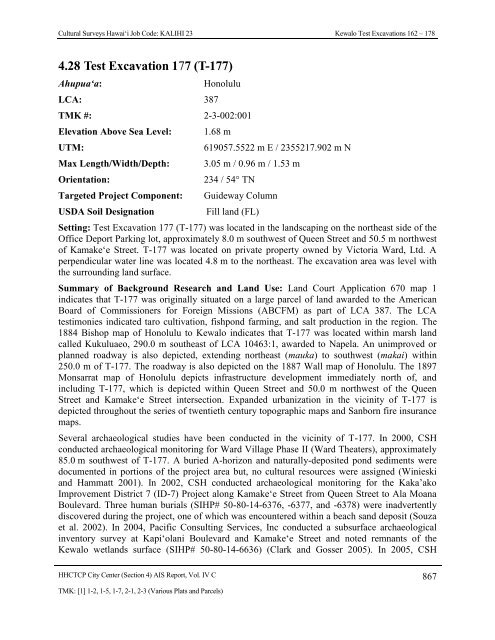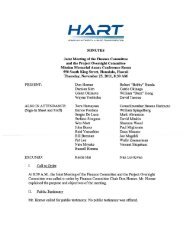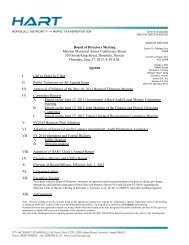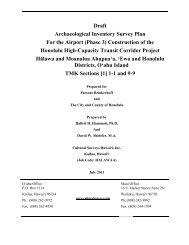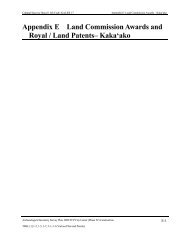4.12 Test Excavation 167 (T-167) - Honolulu Rail Transit Project
4.12 Test Excavation 167 (T-167) - Honolulu Rail Transit Project
4.12 Test Excavation 167 (T-167) - Honolulu Rail Transit Project
Create successful ePaper yourself
Turn your PDF publications into a flip-book with our unique Google optimized e-Paper software.
Cultural Surveys Hawai‘i Job Code: KALIHI 23 Kewalo <strong>Test</strong> <strong>Excavation</strong>s 162 – 1784.28 <strong>Test</strong> <strong>Excavation</strong> 177 (T-177)Ahupua‘a:LCA: 387<strong>Honolulu</strong>TMK #: 2-3-002:001Elevation Above Sea Level:UTM:Max Length/Width/Depth:Orientation:Targeted <strong>Project</strong> Component:USDA Soil Designation1.68 m619057.5522 m E / 2355217.902 m N3.05 m / 0.96 m / 1.53 m234 / 54° TNGuideway ColumnFill land (FL)Setting: <strong>Test</strong> <strong>Excavation</strong> 177 (T-177) was located in the landscaping on the northeast side of theOffice Deport Parking lot, approximately 8.0 m southwest of Queen Street and 50.5 m northwestof Kamake‘e Street. T-177 was located on private property owned by Victoria Ward, Ltd. Aperpendicular water line was located 4.8 m to the northeast. The excavation area was level withthe surrounding land surface.Summary of Background Research and Land Use: Land Court Application 670 map 1indicates that T-177 was originally situated on a large parcel of land awarded to the AmericanBoard of Commissioners for Foreign Missions (ABCFM) as part of LCA 387. The LCAtestimonies indicated taro cultivation, fishpond farming, and salt production in the region. The1884 Bishop map of <strong>Honolulu</strong> to Kewalo indicates that T-177 was located within marsh landcalled Kukuluaeo, 290.0 m southeast of LCA 10463:1, awarded to Napela. An unimproved orplanned roadway is also depicted, extending northeast (mauka) to southwest (makai) within250.0 m of T-177. The roadway is also depicted on the 1887 Wall map of <strong>Honolulu</strong>. The 1897Monsarrat map of <strong>Honolulu</strong> depicts infrastructure development immediately north of, andincluding T-177, which is depicted within Queen Street and 50.0 m northwest of the QueenStreet and Kamake‘e Street intersection. Expanded urbanization in the vicinity of T-177 isdepicted throughout the series of twentieth century topographic maps and Sanborn fire insurancemaps.Several archaeological studies have been conducted in the vicinity of T-177. In 2000, CSHconducted archaeological monitoring for Ward Village Phase II (Ward Theaters), approximately85.0 m southwest of T-177. A buried A-horizon and naturally-deposited pond sediments weredocumented in portions of the project area but, no cultural resources were assigned (Winieskiand Hammatt 2001). In 2002, CSH conducted archaeological monitoring for the Kaka’akoImprovement District 7 (ID-7) <strong>Project</strong> along Kamake‘e Street from Queen Street to Ala MoanaBoulevard. Three human burials (SIHP# 50-80-14-6376, -6377, and -6378) were inadvertentlydiscovered during the project, one of which was encountered within a beach sand deposit (Souzaet al. 2002). In 2004, Pacific Consulting Services, Inc conducted a subsurface archaeologicalinventory survey at Kapi‘olani Boulevard and Kamake‘e Street and noted remnants of theKewalo wetlands surface (SIHP# 50-80-14-6636) (Clark and Gosser 2005). In 2005, CSHHHCTCP City Center (Section 4) AIS Report, Vol. IV C 867TMK: [1] 1-2, 1-5, 1-7, 2-1, 2-3 (Various Plats and Parcels)


